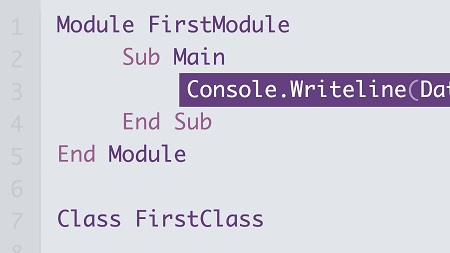
English | MP4 | AVC 1280×720 | AAC 48KHz 2ch | 5h 04m | 874 MB
Visual Basic is one of the core Microsoft languages for building desktop, mobile, and web applications. This course was designed to help you start programming with Visual Basic using Visual Studio. Instructor Walt Ritscher jump-starts the course with projects for common application architectures, including console and desktop. Walt then outlines language fundamentals such as data types, strings, operators, conditional code, and looping constructs. Plus, discover how to refactor your code into functions and subs, work with lists, debug your code, handle exceptions, and more.
Topics include:
- Visual Basic syntax
- Using .NET classes in your application
- Declaring variables and data types
- Working with numbers and dates
- Using strings
- Repeating blocks of code with loops
- Evaluating conditions with if, then, and else
- Debugging and handling exceptions
- Working with lists
Table of Contents
1 Write applications with Visual Basic
2 What you should know
3 Install Visual Studio
4 Setup packages
5 How to access the sample code on GitHub
6 Create application with common tools
7 Code containers Modules and classes
8 Run the example code from the EXE
9 Work with the Console class
10 Run the modified code from the EXE
11 The forgiving nature of VB code
12 Optimize the Visual Studio settings
13 Create Console project in Visual Studio
14 Examine the template structure and code
15 Edit the code
16 Compile the project code
17 Run the example code from Visual Studio
18 Run the example code with a debugger
19 What applications can you create
20 Add additional projects to the solution
21 Review the Visual Studio Project template code
22 Choose a startup project
23 Work with a Windows UI project
24 Add click event handler code
25 Add TextChanged event handler code
26 Clone the repository to your computer
27 Open the solution in Visual Studio
28 Work with Git branches
29 Understand default code flow
30 Create a program loop
31 Listen for KeyChar to terminate loop
32 Visual Basic and programming concepts
33 NET and .NET core
34 Use .NET classes in your application
35 Work with variables and constants
36 Use the Code Explorer project
37 Declare a variable
38 Tips to make literals pop in the editor
39 Work with custom and built-in constants
40 Understand variable scope
41 Understand numeric to numeric conversions
42 Convert numeric values
43 Convert and format numbers to string
44 Convert and parse string to numbers
45 Work with strings
46 Work with dates and times
47 Challenge Strings, dates, and parsing
48 Solution Strings, dates, and parsing
49 Understand procedures and methods
50 Add procedures to module
51 Call procedures from the application
52 Add procedures to class
53 Add code to functions
54 Use parameters with procedures
55 Challenge Refactor with parameters
56 Solution Refactor with parameters
57 Add breakpoints to code
58 Step through code
59 Use the Watch windows
60 Explore the arithmetic operators
61 Explore the comparison and logical operators
62 If and Else
63 Use the And, Or logical operators
64 Use AndAlso, OrElse for better performance
65 Select Case
66 Challenge Logic statements and string compare
67 Solution Logic statements and string compare
68 Use For loop to run code a specific number of times
69 Use Do loops to run code until condition is fulfilled
70 Challenge Pentagonal numbers
71 Solution Pentagonal numbers
72 Explore the collection classes
73 Create new collections
74 Add, remove, and interact with items from list
75 Iterate over list
76 Interesting list properties
77 Work with extension methods
78 Use LINQ with lists
79 Quick look at other collection classes
80 Challenge Marble draw with lists
81 Solution Marble draw with lists
82 What happens when the unexpected happens
83 The default response to unhandled exceptions
84 Use try-catch for exception handling
85 Logging exceptions
86 Next steps
Resolve the captcha to access the links!